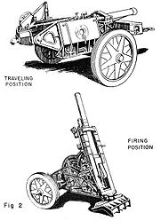
10 cm Nebelwerfer 40
Encyclopedia
The 10 cm Nebelwerfer 40 (10 cm NbW 40) was a heavy mortar
used by Germany
during the Second World War. Much like the American M2 4.2 inch mortar
it was intended to deliver chemical munitions, such as gas and smoke shells, as well as ordinary high-explosive shells. It was derived from Rheinmetall
's Nebelwerfer 51 and 52 prototypes of the late Thirties which were attempts to develop a more accurate and longer-ranged mortar than the 10 cm Nebelwerfer 35
. The NbW 40 is one of the better examples of German over-engineering since it fired a slightly heavier bomb over twice as far as the NbW 35, but weighed almost eight times more than the earlier model.
It was an innovative breech-loading design with the wheels permanently attached to the carriage, from which it was fired, and which wasn't disassembled for transport. It replaced the NbW 35 in ( "smoke or fog-thrower") battalions belonging to the Chemical Corps of the Heer
; exactly how the American fielded their own M2s in chemical mortar battalion
s. It was replaced by the 15 cm Nebelwerfer
41 multiple rocket launcher
from 1941.
, Finland and Russia.
Mortar (weapon)
A mortar is an indirect fire weapon that fires explosive projectiles known as bombs at low velocities, short ranges, and high-arcing ballistic trajectories. It is typically muzzle-loading and has a barrel length less than 15 times its caliber....
used by Germany
Germany
Germany , officially the Federal Republic of Germany , is a federal parliamentary republic in Europe. The country consists of 16 states while the capital and largest city is Berlin. Germany covers an area of 357,021 km2 and has a largely temperate seasonal climate...
during the Second World War. Much like the American M2 4.2 inch mortar
M2 4.2 inch mortar
-External links:* early detailed article on 4.2 mortar...
it was intended to deliver chemical munitions, such as gas and smoke shells, as well as ordinary high-explosive shells. It was derived from Rheinmetall
Rheinmetall
Rheinmetall AG is a German automotive and defence company with factories in Düsseldorf, Kassel and Unterlüß. The company has a long tradition of making guns and artillery pieces...
's Nebelwerfer 51 and 52 prototypes of the late Thirties which were attempts to develop a more accurate and longer-ranged mortar than the 10 cm Nebelwerfer 35
10 cm Nebelwerfer 35
The 10 cm Nebelwerfer 35 was a heavy mortar used by Germany during World War II. Much like the American M2 4.2 inch mortar it was intended to deliver chemical munitions, such as gas and smoke shells. Unlike the American weapon it appears to have had an ordinary high-explosive shell from the...
. The NbW 40 is one of the better examples of German over-engineering since it fired a slightly heavier bomb over twice as far as the NbW 35, but weighed almost eight times more than the earlier model.
It was an innovative breech-loading design with the wheels permanently attached to the carriage, from which it was fired, and which wasn't disassembled for transport. It replaced the NbW 35 in ( "smoke or fog-thrower") battalions belonging to the Chemical Corps of the Heer
Heer (1935-1945)
The Heer was the Army land forces component of the German armed forces from 1935 to 1945, the latter also included the Navy and the Air Force...
; exactly how the American fielded their own M2s in chemical mortar battalion
Chemical mortar battalion
The United States chemical mortar battalions were army units attached to U.S. Infantry divisions, and it was their responsibility to service the 4.2 in chemical mortar during World War II. For this reason they were also called the "Four-deucers"....
s. It was replaced by the 15 cm Nebelwerfer
Nebelwerfer
The Nebelwerfer was a World War II German series of weapons originally designed to deliver chemical weapons. They were initially developed by and assigned to the Wehrmacht's so-called Chemical Troops ...
41 multiple rocket launcher
Multiple rocket launcher
A multiple rocket launcher is a type of unguided rocket artillery system. Like other rocket artillery, multiple rocket launchers are less accurate and have a much lower rate of fire than batteries of traditional artillery guns...
from 1941.
Operational use
They began to replace the 10 cm Nebelwerfer 35 mortars from late 1941 in the Nebelwerfer battalions, and Gebirgs-Werfer-Abteilung (Mountain Mortar Battalion) 10 plus the first battalion of the Nebel-Lehr Regiment (Demonstration Regiment) and saw service in the North AfricaNorth Africa
North Africa or Northern Africa is the northernmost region of the African continent, linked by the Sahara to Sub-Saharan Africa. Geopolitically, the United Nations definition of Northern Africa includes eight countries or territories; Algeria, Egypt, Libya, Morocco, South Sudan, Sudan, Tunisia, and...
, Finland and Russia.

